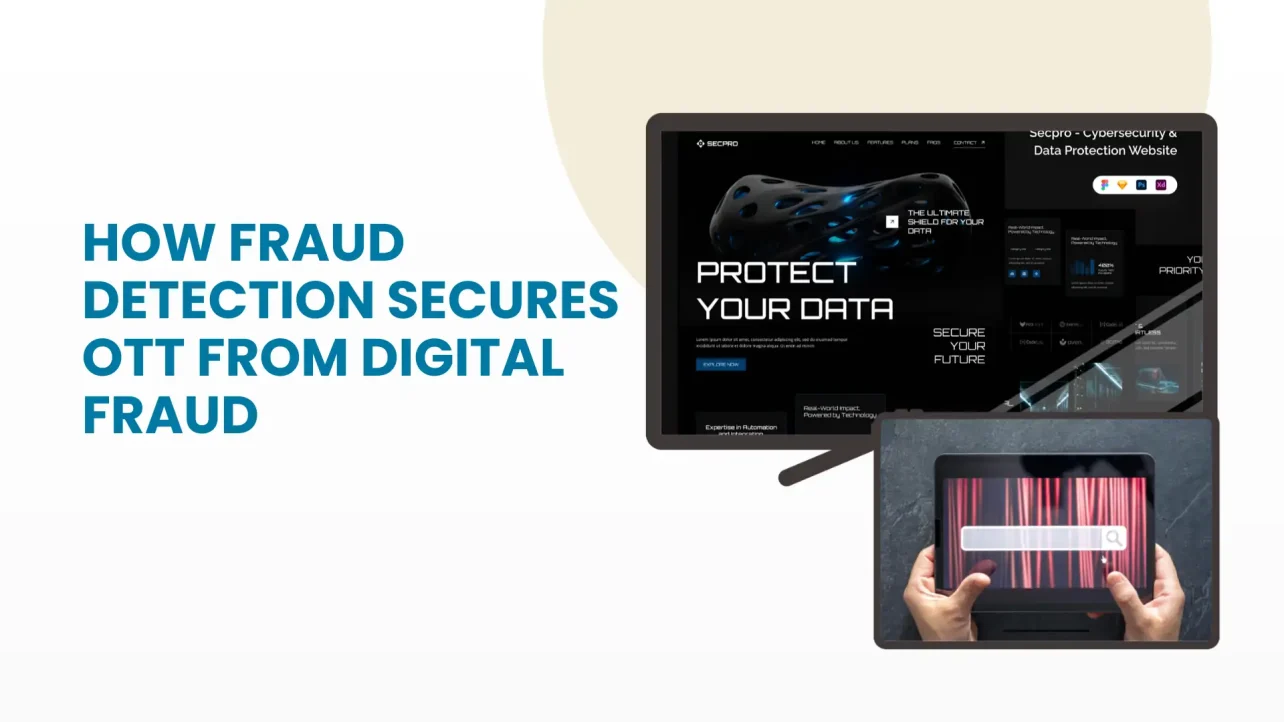OTT Platforms Rapidly Step Up Against Digital Fraud
The advent of Over-the-Top (OTT) streaming services transformed the way content is consumed, offering the convenience of streaming videos at one’s convenience. The proliferation of Video on Demand (VOD) solutions and live streaming services is facing a new threat from digital fraudsters. Fraud is becoming increasingly sophisticated, including everything from fake user registrations to impersonation and illegal access.
OTT platform providers have started to place a higher emphasis on detection and preventive mechanisms as a core component of their platform ecosystems. Industry leaders have begun integrating fraud detection AI to reinforce their services. Whether using a white-label OTT solution or developing a custom OTT platform, protecting digital assets and subscriber information has become a primary focus.
Streaming OTT platforms, notably those offering freemium or ad-supported models, are facing unique challenges with fraud. Automated bot traffic can manipulate user engagement metrics, leading to a negative impact on advertiser trust and return on investment (ROI) from their campaigns. To combat this, content and user data integrity have become a primary focus for OTT service providers, leading to the implementation of advanced fraud detection systems.
Inside Modern Fraud Detection Systems for Streaming Platforms
Today’s streaming and content sharing platforms have sophisticated fraud detection systems that utilize BIM and AI. These systems focus on chargebacks, user logins, streaming activities, and payments to identify fraud and streaming anomalies, scanning countless data user behaviors.
Fraud prevention systems utilize artificial intelligence, machine learning, and deep learning for comprehensive behavioral and login pattern analyses in order to detect and prevent unauthorized access. Such systems are capable of identifying and flagging abnormal behaviors, including login attempts from diverse geolocations, brute-force attempts, as well as session hijacking. Advanced systems are also capable of identifying users who created accounts with the sole purpose of defrauding the system, allowing for the identification of accounts created with temporary emails or stolen identities.
Such real-time monitoring and detection systems are crucial for Over the Top content (OTT) service providers, especially those with regional or global events. The ability to monitor streaming fraud analytics in real-time is highly effective for instant actions such as IP address blocking or locking accounts, aiding in maintaining uninterrupted streaming.
OTT content in action: How streaming giants are fighting back
Regional streaming giants as well as global leaders such as Netflix and Disney+ are incorporating automated fraud detection systems into their architectures. These systems not only track suspicious activities such as login attempts from unauthorized geolocations but also aid in enforcing geo-blocking, subscription limits, and even account sharing policies.
OTT service providers are also tailoring strategies for fraud detection and prevention to align with their specific business models. For instance, a platform providing a live streaming service is likely to target combat streaming hijacking and illegal redistribution of the content. In contrast, a video on demand (VOD) service is more likely to focus on scuppering account sharing and downloads of content.
Fraud intelligence teams, supplemented by advanced automated systems, use a combination of automated technology and human insights to identify shifts in trends and detect new attack vectors. Such a combination guarantees that fraud detection and prevention strategies are adaptable and proactive towards emerging new threats.
How P2P Tech Revolution: A Double-Edged Sword for OTT Streaming
While P2P streaming is effective in scaling the delivery of content, it also significantly raises new security challenges. Though it reduces costs for content delivery networks and improves latency, it also greatly raises the risks of malicious entities altering the stream data or injecting malicious code.
P2P based OTT streaming services are turning to advanced fraud prevention systems that validate each peer node to guarantee the stream’s legitimacy. These fraud prevention systems ensure that only known and trusted devices are allowed to collaborate, thereby greatly reducing the risks of content piracy.
In addition, the OTT service providers are also implementing the use of blockchain technology for stream validation and fraud detection powered by AI to keep the content unaltered in distributed environments. There is no doubt that the P2P revolution is changing the streaming world as we know it, but without effective integrated fraud detection, it poses a lot of risks.
Travent Technology Leads Innovation in OTT Fraud Detection
Travent Technology is a frontrunner in fraud prevention technology in the OTT sector. Their specialized fraud prevention software powered by AI is tailored for content-based enterprises, making them a preferred partner for OTT solution providers in India and across the globe.
Their platform provides a comprehensive fraud analysis engine which scrutinizes logins, billing, content interaction, and the geographic locations from which the content is accessed. Each fraud attack is different making real-time AI adaptation and learning a prerequisite for robust fraud protection, which Travent provides for every stream.
Travent connected OTT video solution providers gain access to enhanced fraud visibility, stratified risk assessment, and anticipatory alerts. Their OTT-based video franchise models, video on demand (VOD) systems, and live video stream application software benefit from effortless integration, enabling comprehensive fraud protection that scales with business growth.
Strengthening Digital Privacy on OTT Platforms with Fraud Detection
Fraud technology is key to privacy for OTT platforms. Data protection is essential for global operations, especially for countries with stringent compliance frameworks. Balancing personalization with privacy boundaries is made easier with fraud prevention systems in place.
Platforms that include embedded fraud prevention and detection features can now analyze user behavior without revealing personally identifiable information. Experiences that require a user’s personally identifiable information such as data masking, secure tokenized sessions, and consent-driven analytics are now being powered by fraud detection AI.
Custom OTT application development teams are embracing privacy-centered features such as biometric login and encrypted payment systems. OTT platform providers are integrating privacy protocols alongside fraud intelligence which encourages privacy-centered features, helping to foster trust and long-term subscriber loyalty.
Protecting Global OTT Platforms from Bot Attacks, Credential Theft, and Piracy
One of the deadliest types of digital fraud which impacts OTT platforms is piracy. Automated bots, credential theft, and illegal stream redistribution are all activities that pose serious threats to revenue generation. Fraud detection systems are equipped to identify, block, and alert users of such activities in real-time.
Suspicious non-human traffic patterns and device behavior are analyzed through AI. Streams that have been downloaded without authorization, anomalous activity during stream playback, and the use of a single account from several geographic locations are further identified by fraud analytics software.
Loss of revenue and reputation will affect OTT platforms that overlook such issues. OTT platforms can protect their reputation and revenue by utilizing fraud prevention software that limits access to content to only genuine subscribers. This has become essential for both niche players and the best OTT streaming solution provider in competitive markets.
OTT monetization can be negatively impacted by subscriber churn. Various forms of fraud can lead to a perpetual cycle of subscription churn, increased operational cost, and loss of confidence from vendors which cumulatively slow down a streaming economy.
Fraud prevention, for instance, can significantly reduce losses fraud in streaming services can inflict. Advanced fraud detection on platforms can employ advanced analytics to identify high-risk users and enforce stringent access control for premium content access.
Fraud prevention and detection is paramount in formulating a potent monetization model for a VOD service provider. This means effective fraud protection will help OTT accelerators lose less revenue and increase loyalty by optimizing their marketing strategies.

AI-Based Fraud Prevention and OTT Security Data Analytics
The detection and prevention of fraud, especially using new technologies, is one area that is capturing a lot of attention, and for good reasons. An AI fraud engine can scan big data repositories and discover patterns of fraud far removed from the reaches of human analysts. Such intelligence is critical for OTT streaming and platforms that have to manage millions of users.
Over time, the precision of fraud detection systems improves as they are analyzed by machine learning models. Platforms also enjoy the additional advantage of receiving predictive alerts that make it possible to prevent fraud before it can affect services or revenue. Many OTT platform providers are now using these models together with risk-based authentication to change the users’ access permissions in real time.
The prioritization of fraud intelligence dashboards by risk scoring also increases with the use of AI, augmenting fraud detection capabilities. OTT providers can now defend themselves far more effectively and more intelligently by responding to alerts in real time and scale, thus preserving system performance even as it fortifies system defenses.
Global Fraud Detection Trends in OTT Security
The evolution of OTT technology is paralleled by the evolution of fraud. The new emerging trends in fraud detection are biometric access control, AI-based behavioral fraud analysis, and blockchain-based DRM. The combination of these technologies is what is defining the new generation of OTT security.
Fraud detection strategies that integrate AI, blockchain technology, and human supervision are increasingly being implemented by OTT solution providers in India and across the globe. Such hybrids adapt to newer and older methods of fraud, proving to be more resilient.
On the other hand, white label video on demand services are automating fraud prevention features, leveling the playing field between smaller and larger brands. OTT providers are required to offer more content and effortless access in response to viewer demand. Such providers are required to continue advancing their fraud prevention technologies to stay ahead.
Conclusion: OTT Providers Worldwide Implement Better Fraud Prevention
Fraud in OTT platforms is rampant. From bots to piracy, the risks are countless. Besides the risks, supplemental OTT platforms are no longer a luxury, but a necessity within the entertainment domain.
AI and other advanced technologies are being integrated into OTT platforms, turning fraud detection into a profit for the providers. There are countless opportunities for fraud, ranging from bots and piracy to credential theft and fake accounts. Embracing advanced technologies such as AI, analytics, and machine learning allow OTT platforms to build and scale while feeling confident their offerings are secured.
The leading over-the-top (OTT) platforms of 2025 will focus on protecting their intellectual property assets just as much as the content they provide. The ability to detect fraud will serve as a competitive advantage.


No comments yet